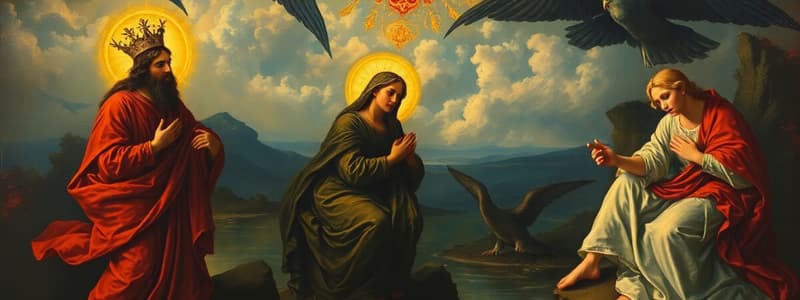Podcast
Questions and Answers
What is the main purpose of religion in inspiring art?
What is the main purpose of religion in inspiring art?
- To convey ideas and beliefs (correct)
- To challenge social norms
- To create abstract representations
- To showcase technological advancements
Which of the following concepts refers to the depiction of realistic objects in their natural settings?
Which of the following concepts refers to the depiction of realistic objects in their natural settings?
- Fantasy
- Abstraction
- Naturalism (correct)
- Realism
What characterizes the art form of realism?
What characterizes the art form of realism?
- Focus on emotional expressions
- Truthful representation without artificiality (correct)
- Incorporation of supernatural elements
- Depiction of idealized subjects
Which art movement emerged in the nineteenth century as a response to realism?
Which art movement emerged in the nineteenth century as a response to realism?
How do mythological subjects generally represent human behavior?
How do mythological subjects generally represent human behavior?
What is a primary source of inspiration for artists under the category of technology?
What is a primary source of inspiration for artists under the category of technology?
Which art piece is an example of realism?
Which art piece is an example of realism?
What does abstraction in art emphasize?
What does abstraction in art emphasize?
What term is used to describe art pieces that have no specific subject?
What term is used to describe art pieces that have no specific subject?
Which of the following sources is considered the most commonly used in art?
Which of the following sources is considered the most commonly used in art?
What best describes representational art?
What best describes representational art?
Which art form aims to evoke moods or emotions in the viewer without clear representation?
Which art form aims to evoke moods or emotions in the viewer without clear representation?
Which of the following statements is NOT a guide question to determine subject matter in artwork?
Which of the following statements is NOT a guide question to determine subject matter in artwork?
Which of the following is an example of representational art?
Which of the following is an example of representational art?
Art based on stories or folklore that may not be factually verified falls under which category?
Art based on stories or folklore that may not be factually verified falls under which category?
When discussing the source of subjects in artwork, which one of these is considered to be the least common?
When discussing the source of subjects in artwork, which one of these is considered to be the least common?
What is distortion in the context of abstract art?
What is distortion in the context of abstract art?
Which of the following best describes the art movement known as Fauvism?
Which of the following best describes the art movement known as Fauvism?
What does mangling represent in abstract art?
What does mangling represent in abstract art?
How is cubism characterized in abstract art?
How is cubism characterized in abstract art?
What role does symbolism play in abstract art?
What role does symbolism play in abstract art?
Which artist is most notably associated with Dadaism?
Which artist is most notably associated with Dadaism?
What is the primary intent of Dadaism as an art movement?
What is the primary intent of Dadaism as an art movement?
What aspect distinguishes elongation in abstract art?
What aspect distinguishes elongation in abstract art?
Flashcards are hidden until you start studying
Study Notes
Subject and Content of Art
- Subject: The main idea represented in the artwork, capturing its essence.
- Representational Art: Clearly identifiable art depicting real-life subjects; also known as Figurative Art (e.g., "Planting Rice" by Fernando Amorsolo).
- Non-Representational Art: Compositions that do not rely on real-world representation; includes abstract and non-figurative styles, aiming to evoke emotions (e.g., "Composition VII" by Wassily Kandinski).
Sources of Subject Matter
- Nature: The most common source, referring to the natural world and phenomena.
- People: Intriguing subjects in artworks, representing individuals or groups in daily life situations.
- History: Depiction of factual past events, often used for remembrance or education.
- Legends: Artworks based on legendary tales, bringing unverified stories to life.
- Religion: A significant inspiration for visual arts, drawing from religious texts to express beliefs (e.g., "The Hand of God" by Auguste Rodin).
- Mythology: Art inspired by mythological deities, reflecting human-like behaviors in gods and goddesses (e.g., "Medusa" by Luciano Garbati).
- Dreams and Fantasy: Works expressing unconscious thoughts and hidden meanings (e.g., Josephine Wall's pieces).
- Technology: Modern themes illustrated through machines and advancements (e.g., "Humanity Drowning in Technology" by Elizabeth Elkin).
Ways of Presenting the Subject
- Naturalism: Depiction of realistic subjects in natural settings; emphasizes accuracy and detail (e.g., "Hay Making" by Jules Bastien-Lepage).
- Realism: Represents subjects truthfully, steering clear of artificial elements; widely popular for its honest portrayal (e.g., "The Stone Breakers" by Gustave Courbet).
- Abstraction: Emerged as a reaction to realism, focusing on intuition and freedom:
- Distortion: Alters original shapes to express ideas and emotions (e.g., works by Henrietta Harris).
- Elongation: Subjects are lengthened to convey specific meanings (e.g., "High Aspirations" by Ernie Barnes).
- Mangling: Art shows subjects with mutilated or damaged appearances (e.g., "The Weeping Woman" by Pablo Picasso).
- Cubism: Uses geometric forms to represent subjects abstractly (e.g., "Factory, Horta de Ebb" by Pablo Picasso).
- Symbolism: Employs visible signs to convey deeper meanings, engaging viewers through mystery (e.g., "Mona Lisa" by Da Vinci).
- Fauvism: Characterized by strong colors and simplified forms; the term means "the wild beasts," associated with artists like Henri Matisse.
- Dadaism: A playful, experimental protest movement that challenges traditional art principles, often nonsensical and shocking (e.g., works by Marcel Duchamp).
Studying That Suits You
Use AI to generate personalized quizzes and flashcards to suit your learning preferences.




